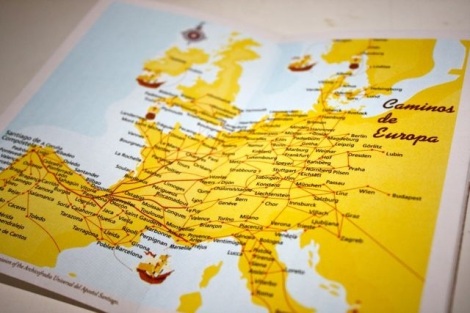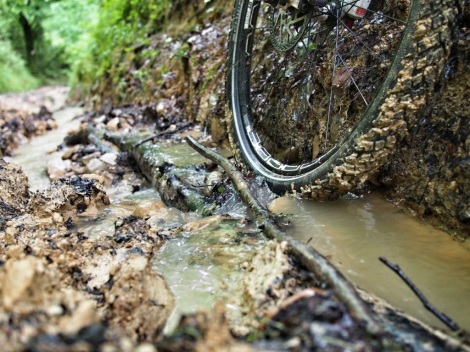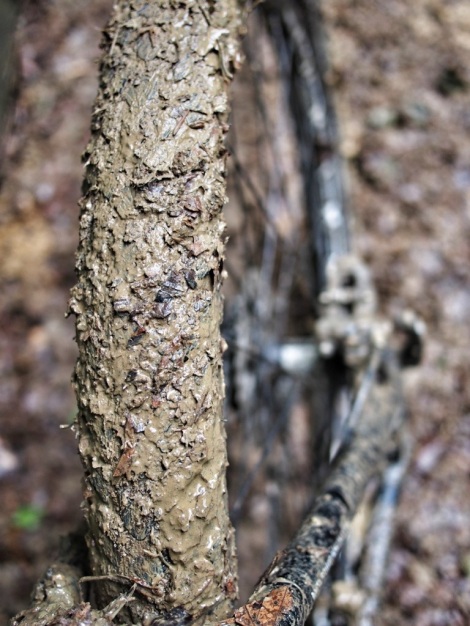
(Image from http://www.millionsteps.org/?page_id=121)
The Camino de Santiago de Compostela forms a web of ancient footpaths crossing Europe towards Santiago de Compostela, in north-western Spain. Originally started as a Roman trade route that took people from all over the empire to what was then the end of the known world, since the Middle Ages pilgrims have walked these paths in their quest to visit the bones of St James, entombed in a silver casket in the impressive cathedral at Santiago.
These days, people travel the route, by foot or bicycle, for many reasons. Some travel for the same religious reasons that drove original pilgrims. Many undertake the trip because they want a break from ‘normal’ life and time to contemplate any number of things, or because they have been forced to take a break and are looking for something to focus on for a few weeks or months. Some want to spend some time being active, outdoors, enjoying good food & wine and meeting a diverse group of other people. Others travel simply to enjoy a beautiful, long distance path through remote areas of France, Portugal and (mainly) Spain. I met all of these people. I suspect that many make the journey for a combination of these reasons, or start for one reason but by the end find that a number apply. I am probably a little bit of most of these people although I’m not at all religious. But I am intrigued by how millions of people have followed these ancient paths, walking in each others footsteps, slowly making their way as far as the path will take them, in search of…something.
The most popular route starts in St Jean Pied du Port, nestled on the French side of the Pyrenees. The route crosses the mountains to Roncesvalles and then heads through northern Spain via Pamplona, Logrono, Burgos, Sahagun, Leon, Astorga and Ponferrada before arriving at Santiago de Compostela. This route is commonly known as the Camino Frances. There are many extensions of this route, crossing France to the Pyrenees, and other Caminos snaking through Spain and Portugal to Santiago. In my haste to work out how to get to the start of the route on the French side of the Pyrenees I decided that heading to Pau would be quite handy. I knew that you could fly there from London, but the thought of having to get through central London for an early flight with a bike packed in a bike box was too traumatic so I investigated trains and discovered that with (quite a few) phone calls to Eurostar and Rail Europe I could book the bike by Eurostar from London to Paris and then TGV from Paris to Pau. Sorted. As I was looking at the map to find a simple way to head across from Pau to St Jean I realised that another Camino route over the Pyrenees (the Camino Aragones in Spain, or the Chemin d’Arles in France) passes through Lescar, just 10 km from Pau. This route crosses the mountains at Somport, heads south to Jaca before turning west and joining the Camino Frances at Puente La Reina. Brilliant, I thought. It may add a few miles but it would less busy than the main route and would avoid having to cover miles to St Jean by road on the first day or playing my bike on buses and local trains. I thought perhaps I could knock out some miles on the first couple of days and not affect my overall schedule.
A little more research made it apparent that the Camino Aragones was much less busy than the Frances route, not as well marked and more remote, with greater distances between villages for accommodation and supplies. But the beauty of being on a bike is that I could be more flexible than walkers and cover more distance. I managed to find a map in Stanfords that covered the route all the way from Somport to Santiago. It was only the night before I left that, as I was searching for information on where I might be able to stay in the first few days on the Camino Aragones, I came across a post on a forum recounting a conversation with the Tourist Office in Lescar advising a walker that the route from Lescar to Oloron St Marie (just 32 km) was “…very arduous“. The walker then went on to say, having walked the route, that “I would not have said arduous, I would have used a stronger adjective, perhaps brutal“.
Hmmm.
Slightly perturbed, I tried to assure myself that people of all ages and fitness levels walk these routes, and it would be much easier than it sounded. I was on a pretty light bike, could cover many more miles than walkers and had been feeling pretty fit. Surely this route couldn’t be that tricky?
I may have been mistaken…


Pingback: el camino, part 2: mud, sweat and gears | (Un)Inspired Ramblings·
Pingback: More bikepacking for pilgrims... | Trails and Tours - Bikepacking·